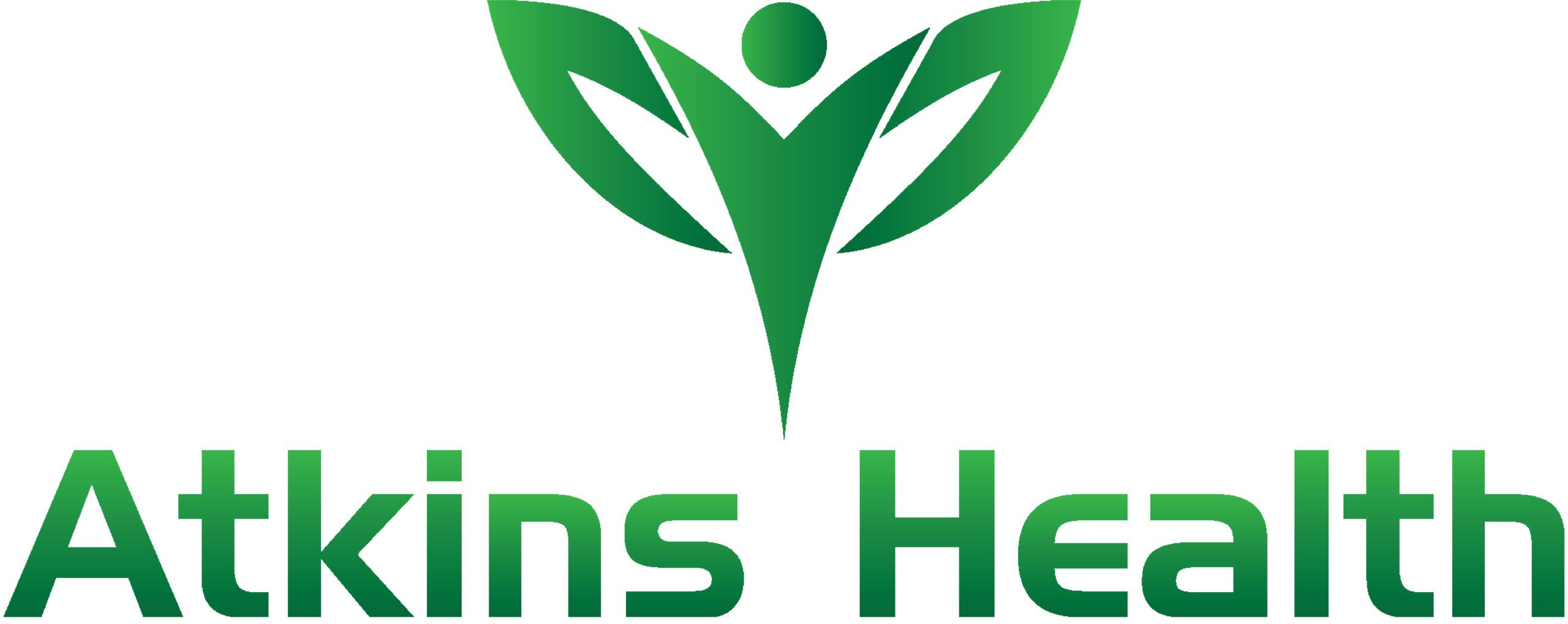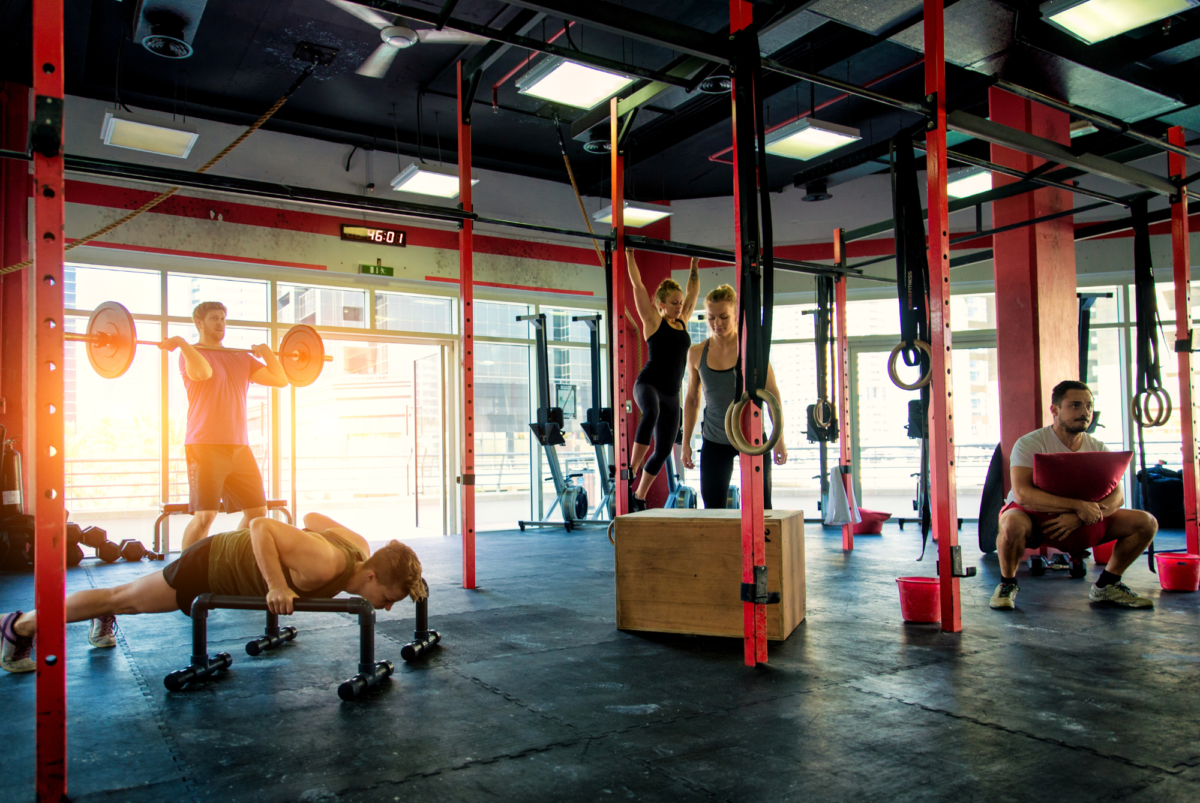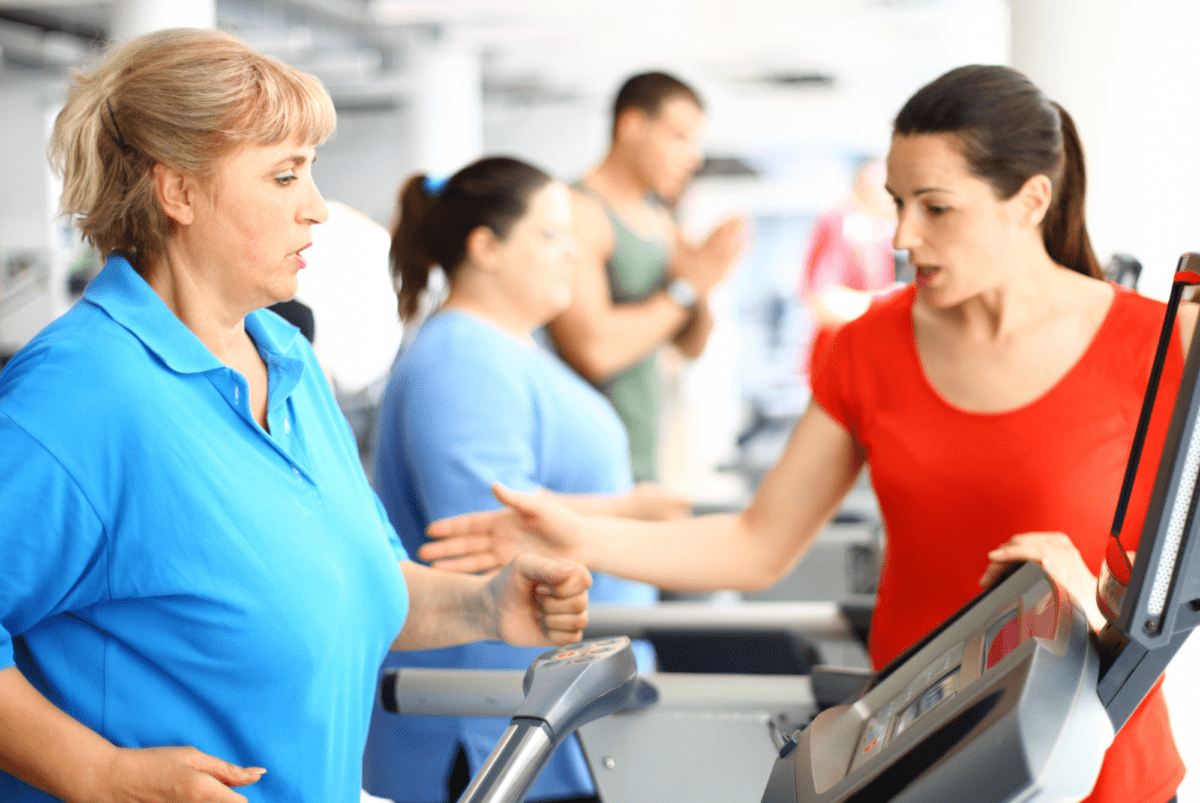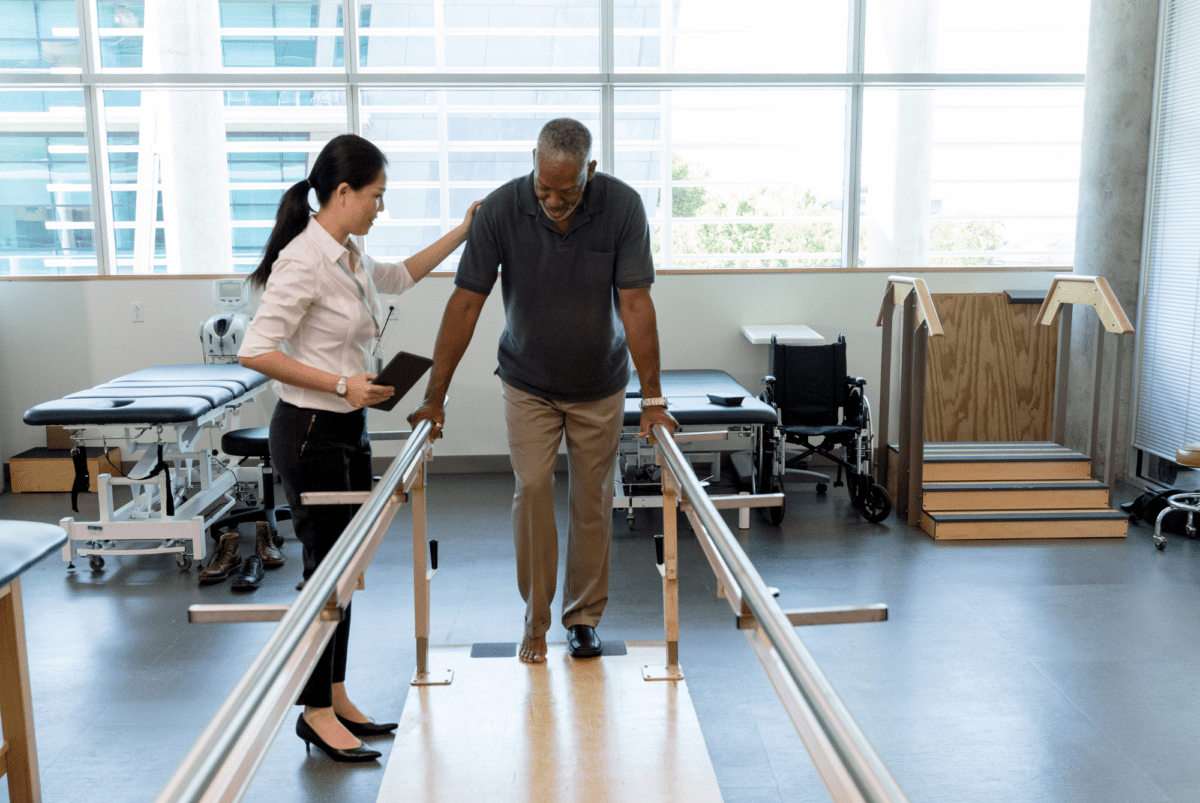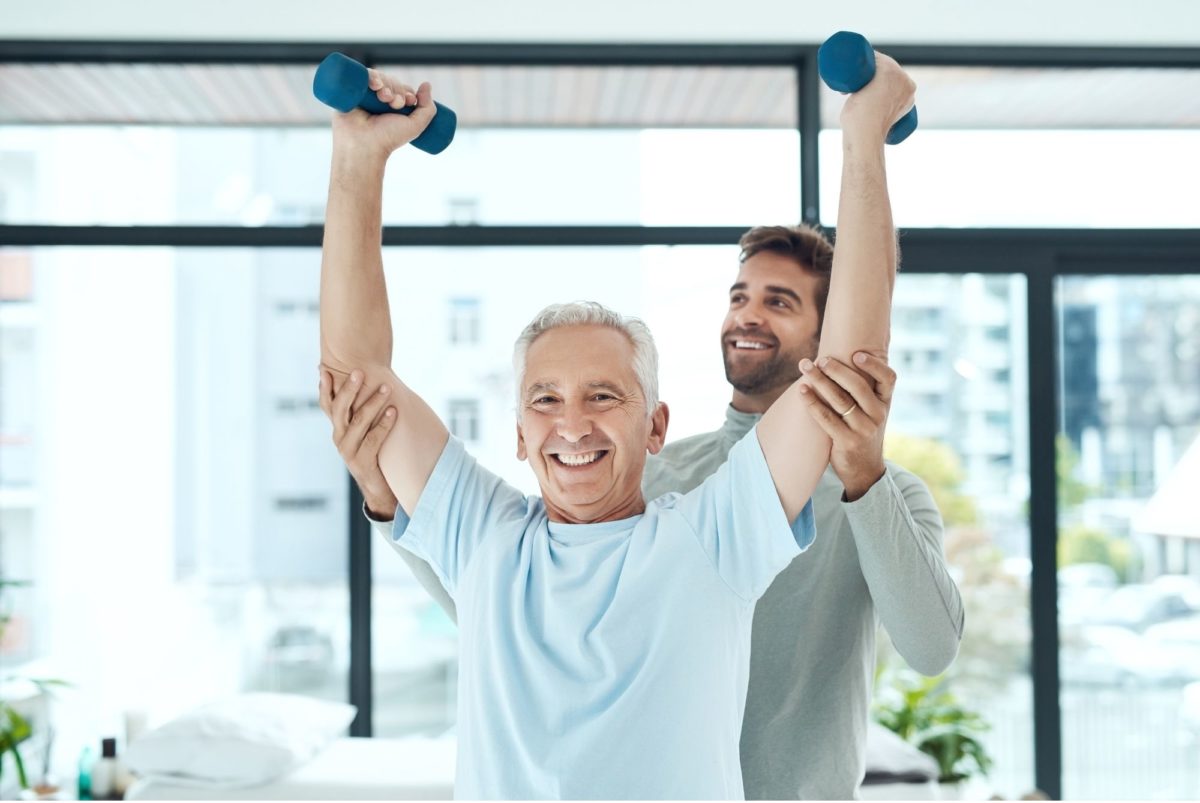Nicole, one of our qualified pre and post-natal coaches, explores the common issue of back pain during pregnancy.
Health Blog and Podcasts
Our Varsity Lakes clinic is home to one of our most extensive service offerings. Located just 500m from Bond University, our clinic offers exercise physiology services, personal training, home visit programs and an extensive range of specialised group classes. From our handy location within Temple Gym, we conduct a range of 1-on-1 and group sessions all tailored to the varying needs of our growing client base.
From 8 through to 108 – we work with clients of all ages to achieve exercise and well-being goals of all degrees. Find out more about our full suite of services to find your perfect fit below.
Our Location and Facilities
Our clinic is located within Varsity Lakes’ Temple Gym, providing us with direct access to state-of-the-art exercise facilities. Temple Gym is quieter than most commercial gyms, offering clients ultimate privacy and comfort during their sessions. It is also fully air conditioned, which is beneficial for our clients with multiple sclerosis that may struggle to regulate their temperature.
Services We Offer
Each of our services is designed to integrate as an end-to-end exercise support offering. Whether you’re an up-and-coming sports star, recovering from an injury, or seeking NDIS funded programs – Atkins Health Varsity Lakes can help.
We often see clients through various stages of their health journey. Our diverse team of professionals allows for efficient and personalised cross-referrals. A client who comes to us for injury rehabilitation with our exercise physiologists may choose to transition into our personal training pathway at the conclusion of the rehab.
Personal Training (PT)
Atkins Health has recently welcomed the addition of a qualified personal trainer into our Varsity Lakes team.
Our personal training and exercise physiology teams will work hand in hand to devise a program that is effective, personalised and expertly backed by both disciplines.
Our personal training is great for people of all fitness levels. Below are a few of the main reasons our clients have sought personal training:
- Accountability: Simply having someone that expects you to show up is a strong motivator
- Personalised programming: Receive a fitness program tailored to your specific goals, needs, and abilities. It can also be adjusted based on your progress and feedback.
- Proper form and technique: Having an expert overseeing your technique can promote efficiency while reducing the risk of injury
- Variety and challenge: Spice things up with an evolving routine and learn new exercises from an expert who is across the latest and greatest exercises
- Goal setting and tracking: Stay focused and motivated with a structured goal map and celebrate your successes along the way.
- Education and guidance: Receive complementary education on proper nutrition and lifestyle habits to support your fitness goals.
Home Care
We specialise in providing home care services for clients with neurological or accessibility issues, as well as those on Lifetime Care Packages or funded by the National Disability Insurance Scheme (NDIS). We can attend homes anywhere in the Gold Coast region – from Tweed Heads to Beenleigh and as far inland as Beaudesert.
Our home care services focus on the basics of exercise and physical activity, such as bodyweight exercises, or band exercises. We work with you to improve your ability to perform the activities of daily living, so that you can enjoy a better quality of life. Our team of exercise physiologists will create a personalised program that meets your specific needs and goals.
One of the advantages of our home care services is accessibility. We understand that some clients may find it difficult to access transport or transfer into a gym, which can be a major obstacle to achieving their health and fitness goals. By bringing our services to your home, we take that problem out of the equation and make it easier for you to get the care you need.
This can also be a great option for respite care for loved ones who are often the primary caretakers for our clients. Our home visits provide caregivers with an opportunity to take a break from their responsibilities, while their loved one participates in an activity that offers cognitive, physical, and social advantages. Our home care visits can also provide a helpful reprieve from loneliness and isolation that patients can often struggle with.
In addition, we also offer a combination of clinic and home care sessions. This is particularly useful for clients who may not want to come to the clinic too often, but still want the benefits of working with our exercise physiologists.
Classes & Programs
Our classes adopt a holistic approach to managing neurological conditions. Our certified trainers incorporate exercise, social interaction and cognitive stimulation into our classes to provide clients with the tools needed to manage their condition effectively.
We prioritise community and strive to create a welcoming environment for everyone. It’s a unique opportunity for patients to take control of their health and wellbeing while connecting with others that can understand and empathise with their experiences.
Our classes are individually tailored to suit each client’s own abilities and to specifically target certain health conditions.
Our Varsity Lakes group program includes the following classes:
- Squad Atkins – a broad class offering that seeks to improve general fitness, strength and mobility, and can be specifically tailored to target any injuries or ailments
- Bone Society – specifically designed to improve bone density and strength, which in turn reduces the risk of falls. Targeting Osteoporosis and Osteopenia.
- Mission MS – specifically designed to enrich the lives of those impacted by Multiple Sclerosis (MS). Mission MS combines the benefits of balance, coordination, strength and endurance-based exercises to improve each participant’s ability to execute daily functions.
- PD Revolution – designed for participants suffering from varying degrees of Parkinson Disease. The program aims to improve gait, reduce freezing episodes, improve balance, improve fine motor skills, delay the need to increase drug treatment and ultimately regain confidence and independence.
- Athletic program – specialised for young athletes looking to improve performance and establish effective long-term training habits and techniques. Is tailored to specific sports and events.
- Active Alzheimer’s – Our program focuses on a proactive approach in delaying the need to go into assisted care. The program uses a blend of physical and cognitive activities that vary from week to week.
1-on-1 Exercise Physiology Sessions
Our 1-on-1 exercise physiology (EP) services provide personalised and evidence-based exercise programs tailored to your individual needs, goals, and abilities. Whether you’re looking to improve your fitness, manage a chronic condition, enhance sports performance or recover from an injury, working with an exercise physiologist can help you achieve your goals.
During your initial consultation at our Varsity Lakes clinic, one of our exercise physiologists will conduct a comprehensive assessment of your health history, fitness level, and any specific needs or concerns you may have. Based on this assessment, we’ll devise a customised exercise plan which we will work with you on in the Temple Gym facilities.
Your exercise program may include a combination of cardiovascular, strength, and flexibility exercises, as well as other specialised exercises or mobility routines.
Working with a 1-on-1 exercise physiologist can help you improve your overall health and fitness, reduce your risk of chronic disease, and improve your quality of life.
Who We can Help
We are fortunate to work with clients young and old at our Varsity Lakes clinic. We regularly work with clients for the following reasons:
- Musculoskeletal disease or dysfunction (including tendinitis, muscle strain, muscle weakness, deterioration)
- Bone Health (including osteoporosis, osteoarthritis, surgical pre/rehabilitation)
- Cancer
- Women’s health issues (including osteoporosis/osteopenia, pelvic floor, endometriosis)
- Neurological disorders (such as Parkinson’s disease and multiple sclerosis)
- Mental health conditions (including depression)
- Pain relief
- Cardiovascular disease
- Pulmonary disease (including asthma, COPD)
- Learning difficulties
- Cognitive disorders
- Weight control
- Diabetes
- Metabolic disorder
If you’re interested in joining our Varsity Lakes community, pop on by or give us a call to find out more.
Receiving a dementia diagnosis can be an extremely emotional experience. The individual may feel grief, loss, anger, shock, fear, and even disbelief. In other instances, it can be a source of relief – an answer and explanation for what was wrong.
Although it’s never easy news to receive, there are immediate pathways to help manage a new diagnosis. Exercise is an effective tool for dementia clients. It not only offers physical and cognitive benefits, but it also provides a supportive community of individuals going through a similar experience. Today we explore the benefits of physical therapy for dementia patients.
The benefit of exercise for dementia
Dementia is a progressive brain disorder that affects behaviour, thinking memory, and the ability to perform everyday tasks. Although there is currently no cure for dementia, exercise can help to slow down its progression and improve the quality of life for those affected by the disease.
Physical benefits
As the disease progresses, many individuals with dementia experience a decline in physical abilities such as balance, coordination, and mobility. Exercise has been shown to help improve these physical abilities, reducing the risk of falls and improving the ability to perform everyday tasks.
On top of this, regular physical activity has been shown to provide the following physical benefits:
- Improve cardiovascular health
- Reduce the risk of chronic diseases such as heart disease and diabetes
- Help to maintain a healthy weight
Cognitive benefits
Perhaps even more significant than the physical benefits that exercise offers, are the cognitive benefits. Regular physical therapy increases blood flow to the brain, which can help to improve memory, concentration, and decision-making abilities.
Exercise has also been proven to stimulate the production of chemicals in the brain which are responsible for improving mood, reducing stress, and increasing feelings of well-being. This can lead to increased self-esteem, confidence and independence.
Social benefits
Joining a physical therapy program specifically for individuals with dementia is a great way to reduce feelings of isolation and loneliness. Exercising among a group of individuals with shared fears and frustrations can be cathartic and build a sense of community among the group.
Group physical therapy for dementia can also provide a community for carers and family members to connect. Carers have an important, yet often challenging, role in the lives of their loved one. Sharing experiences with others in the same position can be an equally rewarding practice for both the individual with dementia, and their inner circle.
In a nutshell – an exercise program is about far more than improving the body’s capacity to move. It’s about fostering a sense of independence and purpose through dynamic, creative, and fun activities – all within a supportive community.
Family respite
Caring for someone with dementia can be highly rewarding. It can also be exhausting and at times and overwhelming. It is important for carers to take time to care for their own wellbeing. Taking a break from your day-to-day caring is referred to as ‘respite’. It’s an opportunity to recharge, rest, and enjoy some independent time to attend to your own business.
Benefits of respite care for caregivers include:
- Allows time to see to personal needs
- Relieve pressure and stress
- Reduce isolation and loneliness
- Helps avoid burnout
An exercise program is a common avenue for respite care. It offers carers a chance to step away from their duties while their loved one engages in an activity that provides mental, physical and social benefits. ‘Active Alzheimer’s’ is Atkins Health’s dedicated Dementia Care Program. It offers a weekly 2-hour window for clients to enjoy exercise under the guidance of professional exercise physiologists (EPs) and geriatricians.
Atkins Alzheimer’s exercise program
Atkin’s Active Alzheimer’s has been designed for newly diagnosed individuals with Alzheimer’s or Dementia. It’s the only community program of its kind and aims to support both clients and their families.
Who is the Active Alzheimer’s for:
- Newly diagnosed individuals with Alzheimer’s or Dementia
- Individuals looking to maintain their independence at home
- Individuals seeking half-day respite care while simultaneously receiving therapy
The program will offer a blend of physical and cognitive activities that vary from week to week. Every exercise is carried out under the expert guidance of our experienced EPs. It ensures your loved one is left in safe, caring and capable hands of a team with a comprehensive understanding of dementia. We know how to identify and minimise fall risks while helping individuals regain a sense of independence.
The results
As a progressive condition, dementia can be debilitating and take a lot of a client’s self-worth and confidence away. Guiding our clients through exercises that they’re confident in can help improve that feeling of self-worth and independence.
One of my personal highlights from the program so far was a client who was eventually able to get out of the shower independently. To have helped her get that little bit of dignity back is way better than any type of metric or testing outcome – it was such an awesome result for her.
Find out more about our Active Alzheimer’s program and how you and your loved one could benefit by filling out the form below or giving us a call.
Exercise – it’s like a superpower for our bodies, providing countless benefits for physical and mental health. While weight loss is often seen as the ultimate goal of exercise, it’s important to realise that most of us don’t need to lose weight to reap the endless rewards of movement.
In fact, many of us who engage in regular exercise do so for reasons that far exceed weight loss. This includes stress relief, improved mood, social interaction, improved cognition, or simply for the enjoyment of movement.
However, for those who are dealing with weight-related health issues such as obesity, diabetes, or heart disease, weight loss can be an important goal for improving overall health and reducing disease risk. In this blog, we’ll explore the role exercise physiology has in weight loss – particularly for those who may need to lose weight to manage health conditions.
Weight does not equal health
Before we go any further, it’s important to realise that weight does not equal health. Using your body weight as the key metric for your overall health and well-being is an outdated and inaccurate measure. There is a growing body of research that suggests weight is not the sole determinant of health, and that people of all body sizes can be healthy.
That’s not to say that exercise doesn’t play a major role in leading a healthy lifestyle. Exercise offers so many benefits that far outweigh the results on the scales. However, exercising with the main objective of weight loss is rarely necessary or sustainable.
In fact, a study by the Journal of Health Psychology found that participants who exercised for weight loss were less likely to stick with their exercise program than those who exercised for reasons such as enjoyment, stress relief, or improved health.
A separate study suggested that those who focused on achieving specific exercise-related goals, such as running a 5K or lifting a certain amount of weight, were more successful in sticking with their exercise program.
That being said, weight loss can still be a powerful motivator for some people, particularly those who are dealing with weight-related health issues. It’s important for each individual to find their own motivation for exercise, whether it’s improving overall health, reducing stress, or achieving specific fitness goals.
With so many reasons to get moving, we encourage our clients to dig a little deeper to find their ‘why’?
Exercise for weight loss
As we touched on above, there are some cases when losing weight may be necessary to manage certain health conditions. Carrying excess weight can put a strain on many of the body’s systems, including the cardiovascular system, the respiratory system, and the musculoskeletal system. There are several health conditions that can be linked to excess weight, and weight loss may be an appropriate goal for managing these conditions.
These include:
- Type 2 diabetes: Obesity is a major risk factor for type 2 diabetes, and weight loss can help improve insulin sensitivity and blood sugar control.
- Cardiovascular disease: Obesity is also a risk factor for heart disease, stroke, and other cardiovascular conditions. Weight loss can help lower blood pressure and cholesterol levels, reducing the risk of these conditions.
- Joint pain: Carrying excess weight can put extra stress on the joints, leading to conditions such as osteoarthritis. Weight loss can help reduce joint pain and improve mobility.
How exercise physiology can help with weight loss
When it comes to weight loss, exercise physiology plays a vital role in helping clients understand the mechanisms by which exercise can help them lose weight.
At Akins Health, our team specialises in devising exercise programs that help manage conditions such as obesity, heart disease, and joint pain. We work closely with our clients to structure a program that not only promotes weight loss but also improves strength, endurance, mobility and functionality – depending on the client’s unique needs and goals.
Through our programming, we incorporate a range of different exercises for weight loss that can be effective for managing overall health. Generally, this includes a blend of cardiovascular training, and strength training. Often our clients may be new to exercise. We find pilates is one of the best exercises for weight loss – particularly for those starting out on their exercise journey.
Pilates emphasises the use of the smaller muscles in the body to support its structure. It is suitable for people of all ages, genders, abilities, and fitness levels, including beginners and elite athletes, because of its low impact nature. Pilates can also be customised for special needs, such as treating clinical conditions. With its focus on the connection between the mind and body and its ability to offer a variety of benefits to individuals at different levels of fitness, Pilates is a highly effective form of exercise.
In most cases, an exercise plan for weight loss is the result of extensive collaboration between our exercise physiologists and personal trainers. The expertise of exercise physiologists can help personal trainers design workout programs that are tailored to the unique needs and goals of each individual, and how to modify exercise programs for individuals with health issues.
If you’re interested in incorporating exercise into your weight management plan or improving your overall health and wellness, our team of exercise physiologists and personal trainers are here to help. Contact us today to schedule an appointment and learn how we can work together to help you unlock the joy of movement.
Pelvic floor therapy is a technical term for an exercise program that aims to strengthen the muscles of the pelvic floor. Weakness in the pelvic floor can often be to blame for symptoms such as incontinence. Urinary incontinence affects almost 38% of Australian women and up to 10% of Australian men.
As one of Atkins’ exercise physiologists specialising in women’s health, I regularly work with patients to manage symptoms associated with weak pelvic floors. In today’s blog I’ll take you through what exactly the pelvic floor is, why it’s so important, and how you can introduce pelvic floor training into your daily routine.
What is your pelvic floor?
Your pelvic floor is like a hammock of muscles that sit between your pubic bone and your tailbone. The pelvic floor has several roles. It controls your urinary and bowel movements, and it’s essential for sexual function. Think of it as a support system for your bladder, your bowel and your uterus. To function efficiently, this hammock of muscles need to be able to contract, lift and hold, as well as relax.
What is pelvic floor therapy?
Pelvic floor therapy is a type of exercise therapy used in the rehabilitation and prehabilitation of the pelvic floor muscles. In a nutshell, it’s a collection of exercises we use to either prevent injury or dysfunction from occurring or relieve the symptoms associated with dysfunction. The main goal is to improve pelvic floor function through exercises, lifestyle modifications, and education.
What causes pelvic floor muscle weakness
Anyone can experience pelvic floor dysfunction – regardless of age, gender or genetics. However, certain groups are more likely to experience pelvic floor dysfunction. Conditions or events that may trigger a change in the pelvic floor include:
- Stress urinary incontinence
- Prolapse
- Hormone changes (such as menopause)
- Childbirth – particularly from prolonged labour
- Obesity
- Certain surgeries
- Heavy lifting
What are the benefits of pelvic floor therapy?
Training the muscles of the pelvic floor can be beneficial in both a preventative and a restorative sense. A strong pelvic floor can help increase the resilience of the muscles following pelvic surgery. It can also reduce the risk of developing incontinence or prolapse.
On the flip side, pelvic floor exercise therapy can help manage symptoms associated with the following:
- Urinary incontinence
- Stool Leakage
- Stool urgency and frequency
- Pelvic organ prolapse
- Abdominal pain
- Pregnancy pain
- Pelvic pain
- Polycystic ovarian syndrome (PCOS)
- Endometriosis
Who is pelvic floor physical therapy for?
Many of us neglect our pelvic floor muscles until something goes wrong – even I am guilty of this. But proactively training and strengthening the muscles of the pelvic floor is something people of all ages can benefit from.
I work with young gymnasts who are prone to stress incontinence, through to postmenopausal women who are adapting to the changes in their bodies. Pelvic floor physical therapy can be an effective treatment for:
- Patients who have recently undergone abdominal, prostate, or pelvic surgery
- Athletes who participate in sports that are prone to causing stress incontinence (gymnastics, athletics, dancing)
- Individuals with an overactive pelvic floor
- Post-menopausal women
- Prenatal and postpartum mothers
Men can benefit from pelvic floor therapy as well as women. The treatment is commonly misconceived as a women-only exercise. However, we often use pelvic floor training as a rehabilitation treatment plan following prostate cancer surgery.
How to strengthen the pelvic floor
The pelvic floor is actually considered part of your ‘core’. Many of us think of the core as another term for the abdominals. The core actually extends from the diaphragm to the pelvis and incorporates the abdominals, as well as the muscles of the pelvic floor and lower back. This is why many pelvic floor exercises may look and feel similar to exercises we typically associate with core strengthening.
It can be difficult to isolate and voluntarily contract and relax the pelvic floor at first. This movement is often referred to as a ‘kegel’ exercise. These exercises can be performed daily. Try the steps below to practice contracting and relaxing your pelvic floor:
- Start by lying on your back, with your knees bent and feet flat. Take a gentle inhale breath for 5 seconds, breathing into your tummy, and gently exhale for 5 seconds.
- Think of your pelvic floor like an elevator, with closing doors, a G floor, and1st floor.
- Start your pelvic floor contraction by ‘closing the elevator doors’ like you are trying to stop the flow of urine.
- Then, gently lift and contract the pelvic floor elevator up to the 1st floor.
- Now relax your pelvic floor, by letting it down back to the G floor, and allowing the doors to open.
- Repeat this up to ten times.
While Kegels are a highly effective form of physical therapy exercises for the pelvic floor, it’s important to recognise that they aren’t a one-trick fix. A pelvic floor strengthening plan should incorporate exercises that work the surrounding muscles. It’s important to not only strengthen the pelvic floor, but the muscles around it too. This includes the transverse abdominals, hip adductors and abductors, and glutes. These exercises can be incorporated as part of a strength training program, and can be performed up to three times per week.
Common exercises to strengthen these muscles, and in turn – the pelvic floor, include:
- Glute bridges
- Sit-to-stands
- Clamshells
- Bird dogs
- Dead bugs
Pelvic floor exercises for men and women are the same, despite the fact that they may be in response to different conditions.
An exercise physiologist can help prescribe you a personalised pelvic floor therapy plan, tailored to your needs. If you’re seeking long-term relief from pelvic floor troubles, the solution is just a consult away.
This article is a guest post written by The Feel Good Society. Get in contact with The Feel Good Society to get two valuable client resources: ‘Painful Periods Mini eGuide’ and ‘Happy Hormones Guide Book’.
Exercise plans are our bread and butter at Atkins Health. We know the ins and outs of movement like no one else. Over time we have built up an arsenal of techniques that help our clients achieve the best outcome possible. Every exercise and fitness plan we implement is different, but there are a few staples that we lean on to build out an effective program. Full body exercises are an efficient, comprehensive approach to training the body. They can be applied to a range of goals – from improving mobility, to maintaining strength, or remedying injury. The following provides a summary of full body exercises – including what they are, why they work, and how to incorporate them into your training.
What are full body exercises?
Full body exercises, also known as compound movements, target several muscle groups in the body at once. While most movements will engage more than one muscle at a time, the best full body exercises will engage various body parts at once. For example, a bicep curl will engage both the front and back of the upper arm, but little more. A squat, however, engages the legs, core and back, all at once.
Popular full-body resistance exercises include:
- Pushups
- Lunges
- Squats
- Dips
- Step-ups
- Deadlift
- Bench press
These movements will typically be more fatiguing than isolated exercises, which makes them highly beneficial for several reasons.
Full bodyweight exercises aren’t just used in strength training. At Atkins, we’re big believers in the benefits of full body mobility exercises. Mobility training is a helpful tool for preventing injury, rehabilitating injuries and increasing the efficiency of training. A mobility routine may often be used in place of full body warm-up exercises
Benefits of these exercises in training
Full-body exercises are a highly efficient way of training the body, however, they’re not appropriate for everyone. If they are not executed with the proper technique, they can result in injury. Furthermore, they can often exacerbate underlying muscle imbalances or weakness.
However, when performed correctly, full-body exercises have proven to be hugely beneficial.
This training technique is particularly popular among athletes due to how closely the exercises can replicate natural movements executed in sport.
Here are a few reasons why we love prescribing full-body exercises for our clients:
- Workout more efficiently, activating more muscles in a short space of time
- Helps improve coordination and balance
- Helps improve joint mobility and stability
- Simultaneously trains the cardiovascular system by increasing heart rate during movement
- Exercise the same muscle group for longer periods with lower levels of fatigue
- Can lift heavier weights and build strength quicker
Your exercise physiologist (EP) will be able to determine how you can benefit most from incorporating full-body exercises.
How to introduce exercises safely and effectively
Because these movements activate so many muscles at once, it’s important to ensure they are performed correctly. An EP can help identify appropriate exercises for your goals and demonstrate how to perform them safely and effectively.
It’s also important to avoid overusing full body exercises in your program. Although they’re a great way to improve strength and cardiovascular fitness, over reliance on such taxing movements can be damaging to the body. Your EP can also help devise an appropriate way to incorporate full body exercises as part of a broader exercise plan.
At Atkins Health, we love to incorporate a blend of full body movements into our classes. Devised by our leading team of experts, our group classes blend individual programming that is specific to your goals, with the joy and energy of a social environmen
If you’re ready to take the plunge into full-body exercising, we can’t wait to take you on the journey. Our team of talented EP’s can kickstart your exercise program, no matter what level of ability, fitness or confidence you are at. Get in touch today to find out more.
Life after a stroke can be challenging. Daily activities, from dressing to speaking, can suddenly become difficult without assistance. In this article, I have put together some of the common questions I get asked about stroke rehabilitation.
A stroke is a serious medical emergency in which the blood supply to the brain is interrupted, causing brain cells to die.
10% of stroke sufferers will recover fully, while 25% will recover partially without being able to do everything they previously could.
Ongoing rehabilitation and treatment can help increase the chances of regaining functionality. As exercise physiologists, one of our main goals when helping clients with stroke recovery is to restore and maintain their level of function.
Over the last eight years, I’ve worked with stroke patients to help them regain independence and confidence through movement.
Here’s how we do it.
What effect can a stroke have on the body?
The impacts of stroke vary significantly from person to person. Lasting complications can depend on the severity of the stroke, as well as any underlying conditions that were already present.
Long-term complications commonly include the following:
- Weakness or absence of movement in limbs
- Fatigue
- Trouble speaking and swallowing
- Sensory changes
- Difficulty reading or writing
- Perceptual changes
- Difficulty walking
- Memory difficulties
The most common denominator across all the clients I’ve seen is the impact on their ability to perform activities involved with day-to-day life. This can be something as simple as getting changed and eating, or it might be more significant mobility issues, such as the ability to walk.
How does EP help stroke rehabilitation
Recovery from a stroke takes time, but it can often transform a person’s quality of life. Exercise plays a crucial role in rewiring neural pathways that were lost as a result of the stroke.
The 6-8 month window immediately following the stroke is a critical period in which the most recovery occurs through exercise intervention.
Even if a limb has suffered a complete loss of movement, improvements can be transferred by working on the opposite limb. Research shows that when we train the unaffected limb, roughly 30% transfers over to the affected limb.
Our primary goal is to restore function on the unaffected limb, by matters of neuroplasticity. In a nutshell, we are regenerating the nerves that connect to the affected limb so that they’re able to use that limb to a certain extent.
The types of exercise we implement can include cardio and mobility training, but will mostly be focused on resistance training. This can take place at home, in the clinic, or in a gym setting.
Pathways for stroke rehabilitation
At Atkins, we offer four ‘pathways’ to stroke rehabilitation. These pathways allow us to cater our treatment approach to different goals. We refer to them as:
- results pathway
- support pathway
- client-managed pathway
- group class pathway
The results pathway is mainly for clients who want to see results quickly and who we feel require ongoing support to reach their goals. It includes 2-3 weekly sessions under our guidance.
Clients on our support pathway typically come in and see us once a week. This is often suitable for clients who are capable of performing the exercises independently, but who still require regular support to keep them progressing.
A client on the client-managed pathway will come in every so often – about once a month. During these sessions, we’ll check compliance with their at-home programs and make any adjustments necessary.
And finally, we have the group class pathway which can work complementary to the client-managed pathway. This is also for clients who are very independent. It allows them to perform the exercises on their own, while also offering a social aspect and feedback from the instructor throughout the session. It helps clients ensure their technique is correct and that they’re complying with their programs.
Squad Atkins is one of our most popular classes and allows clients to carry out their individual programs in a lively and supportive environment.
Atkins Health Stroke Treatment
Just last month I had a client come to me with the goal to get back into running after suffering a stroke a year ago. He’s very functional but was struggling with his gait. His level of commitment immediately stood out to me. His determination to come in every single week has already seen his walking improve significantly in just a few weeks. There’s still a long way to go, but already he’s much happier with how much he’s progressed and how much he’s actually improved.
Locations for Stroke Rehabilitation Services
We offer exercise physiology for stroke rehabilitation at all Atkins Health locations as well as in home visits.
At Atkins, it’s never too late to start your recovery journey. We can accommodate treatment on a group or individual basis, always catering to your unique goals and programming.
Rewire neural pathways through exercise physiology, to help manage Parkinson’s Disease and its symptoms including tremors, imbalance and stiffness.
Rewire neural pathways through exercise physiology, to help manage Parkinson’s Disease and its symptoms including tremors, imbalance and stiffness.

